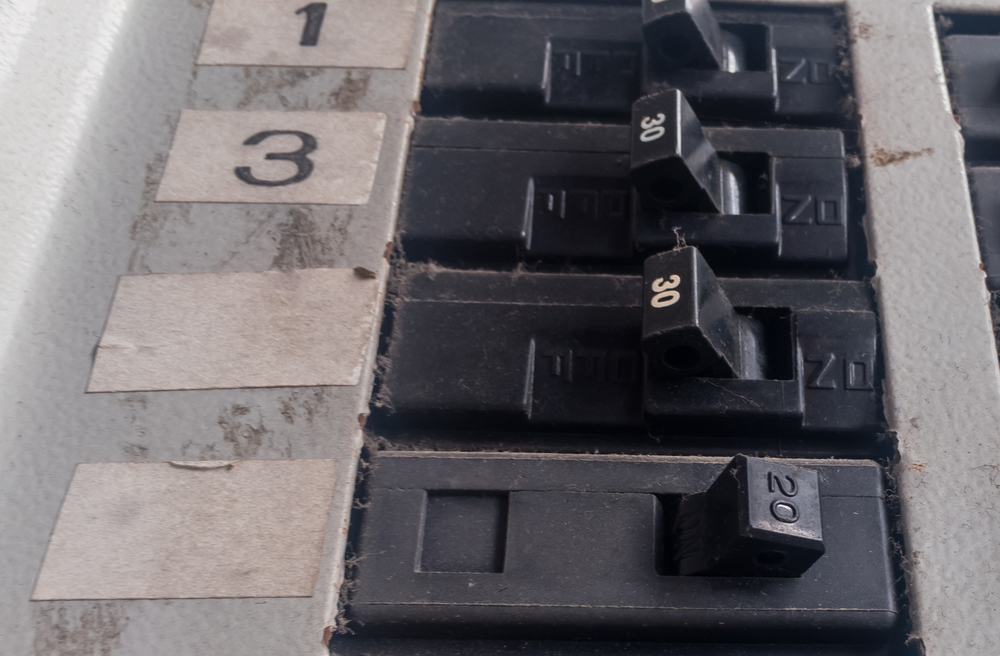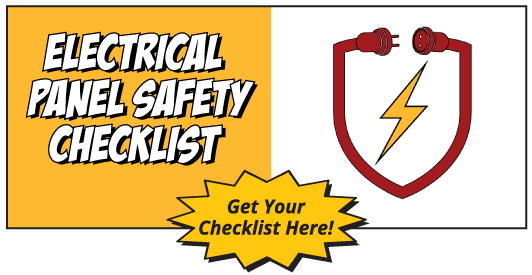Are you familiar with your home’s breaker box?
How about the parts of a breaker box or electrical panel?
If you’re not, you should familiarize yourself with it since a properly functioning, properly sized breaker box stands between  your family and an electrical fire.
your family and an electrical fire.
A breaker box — aka electrical panel — is mounted on the wall, usually in the basement of a home, and its purpose is to take in electricity supplied by your power company and redistribute it throughout your home via electrical circuits. As a local Kansas City electrician, we can confirm that inside the breaker box are the following components:
Circuit Breakers
These are rocking switches that act as safety devices to quickly shut off power to a circuit when there’s too much electricity flowing through it. When that happens, and the breaker rocks to the “off” position, we say that the circuit breaker for that zone has “tripped”.
Most of the circuit breakers in your breaker box are single pole breakers, meaning they can handle 120 volts of power and are either 15 or 20 amps. (Remember 15 and 20 amp fuses?  Circuit breakers are the modern equivalent of those old-fashioned devices.) Some of the circuit breakers — the ones that look like two single breakers stuck together — are double pole breakers. As you may have guessed, they can handle a larger power load of 240 volts and are typically between 15 and 125 amps. These are for the large appliances in your home like your refrigerator, stove, clothes dryer, water heater, etc.
Circuit breakers are the modern equivalent of those old-fashioned devices.) Some of the circuit breakers — the ones that look like two single breakers stuck together — are double pole breakers. As you may have guessed, they can handle a larger power load of 240 volts and are typically between 15 and 125 amps. These are for the large appliances in your home like your refrigerator, stove, clothes dryer, water heater, etc.
There are also some “special purpose” breakers designed to provide your home with extra protection from fire (Arc Fault Circuit Interrupters or AFCIs) and electrocution (Ground Fault Circuit Interrupters or GFCIs).
Service Disconnect Switch
This is where the electricity that powers your home comes into the electrical panel. The service disconnect — sometimes called the main breaker — looks like a larger version of a circuit breaker and is usually found at the very top or bottom of the breaker box. It can handle 100 to 200 amps. In case of emergency, this is where you can turn off power to your home by rocking the switch to the “off” position.
Expansion Slots
These are empty slots that are there to accommodate extra circuit breakers when a licensed electrician adds additional circuits to your home due to, for example, a room addition.
Determining the Right Size Breaker Box for Your Needs
Most homes have either 100 or 200-amp breaker boxes. This refers to the amount of electricity the electrical panel can handle. Most newer homes opt for the larger size to accommodate the ever-growing collection of electrical devices in a modern household. If you have a 100-amp box and need more circuits, you can either add a “sub-panel” or upgrade to the larger 200-amp breaker box.
Replacing a Breaker Box
The average lifespan of a breaker box is 60 years, but this can vary, and the circuit breakers themselves can stop working properly and fail to turn off electricity to an overloaded circuit as a result. For that reason, it’s a good idea to have your breaker box inspected to see if it needs repair or replacement by a licensed electrician, especially if you live in an older home and you aren’t sure of the age of the electrical panel, another reason to know the parts of a breaker box as well.


